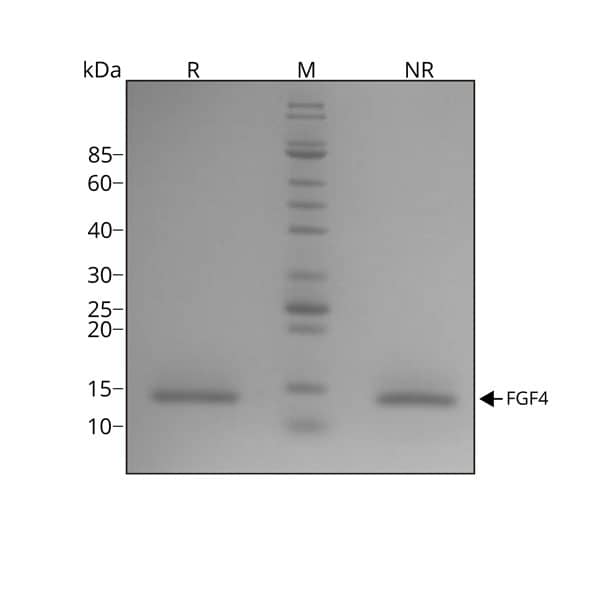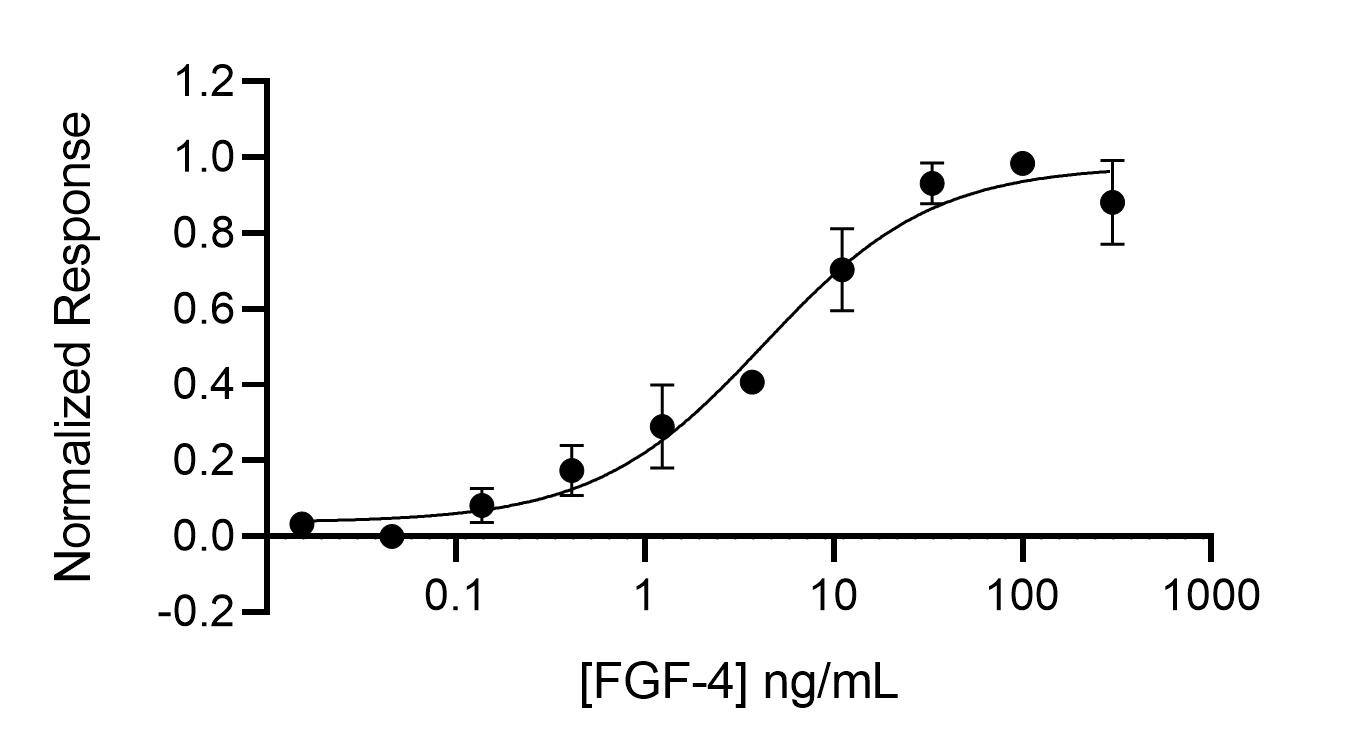Recombinant Human FGF-4, Animal-Free Protein
R&D Systems, part of Bio-Techne | Catalog # Qk004

Key Product Details
Product Specifications
Source
Purity
Endotoxin Level
Predicted Molecular Mass
SDS-PAGE
Activity
Mycoplasma
Scientific Data Images for Recombinant Human FGF-4, Animal-Free Protein
Recombinant Human FGF-4, Animal-Free Protein Bioactivity
Recombinant HumanFGF-4, Animal-Free activity is determined using the firefly luciferase reporter assay (*) in stably transfected HEK293T cells. Cells are treated in triplicate with a serial dilution of FGF-4. Firefly luciferase activity is measured and normalized. EC50 = 4.3 ng/mL (306.5 pM). *Promega pGL4.33[luc2P/SRE/Hygro] #E1340Recombinant Human FGF-4, Animal-Free SDS-PAGE
Recombinant human FGF-4 (Catalog # Qk004) migrates as a single band at 14 kDa in non-reducing conditions (NR) and upon reduction (R). No contaminating protein bands are visible.Purified recombinant protein (7 µg) was resolved using 15% w/v SDS-PAGE in reduced (+ beta-mercaptothanol, R) and non-reduced conditions (NR) and stained with Coomassie Brilliant Blue R250.Formulation, Preparation and Storage
Qk004
| Formulation | Lyophilized from HEPES/NaCl/mannitol |
| Reconstitution | Resuspend in water at >100 µg/ml, prepare single use aliquots, add carrier protein if desired. |
| Shipping | The product is shipped lyophilized at ambient temperature, on ice blocks or on dryice. Shipping at ambient temperature does not affect the bioactivity or stability ofthe protein. Upon receipt, store immediately at the conditions stated below. |
| Stability & Storage | Store lyophilized protein between -20 °C and -80 °C until the date of expiry. Avoid freeze-thaw cycles. |
Background: FGF-4
FGF‑4 (fibroblast growth factor‑4), also known as FGF-K or K‑FGF (Kaposi’s sarcoma-associated FGF), is a 25 kDa secreted, heparin‑binding member of the FGF family (1, 2). The human FGF‑4 cDNA encodes 206 amino acids (aa) with a 33 aa signal sequence and a 173 aa mature protein with an FGF homology domain that contains a heparin binding region near the C‑terminus (2). Mature human FGF‑4 (aa 71‑206) shares 91%, 82%, 94% and 91% aa identity with mouse, rat, canine and bovine FGF‑4, respectively. Human FGF‑4 has been shown to exhibit cross species activity. Expression of FGF-4 and its receptors, FGF R1c, 2c, 3c and 4, is spatially and temporally regulated during embryonic development (1, 3). Its expression in the mouse trophoblast inner cell mass promotes expression of FGF R2, and is required for maintenance of the trophectoderm and primitive endoderm (3‑5). Later in mouse development, FGF‑4 works together with FGF‑8 to mediate the activities of the apical ectodermal ridge, which direct the outgrowth and patterning of vertebrate limbs (3, 6‑9). FGF-4 is proposed to play a physiologically relevant role in human embryonic stem cell self-renewal. It promotes stem cell proliferation, but may also aid differentiation depending on context and concentration, and is often included in embryonic stem cell media in vitro (10‑12). A C‑terminally truncated 15 kDa isoform that opposes full‑length FGF‑4 and promotes differentiation is endogenously expressed in human embryonic stem cells. FGF‑4 is mitogenic for fibroblasts and endothelial cells in vitro and has autocrine transforming potential (13). It is a potent angiogenesis promoter in vivo and has been investigated as therapy for coronary artery disease (14).
References
- Reuss, B. and O. von Bohlen und Halbach (2003) Cell Tiss. Res. 313:139.
- Hebert, J.M. et al. (1990) Dev. Biol. 138:454.
- Niswander, L. and G.R. Martin (1992) Development 114:755.
- Feldman, B. et al. (1995) Science 267:246.
- Goldin, S.N. and V.E. Papaioannou (2003) Genesis 36:40.
- Sun, X. et al. (2002) Nature 418:501.
- Boulet, A.M. et al. (2004) Dev. Biol. 273:361.
- Yu, K and D.M. Ornitz (2008) Development 135:483.
- Mariani, F.V. et al. (2008) Nature 453:401.
- Johannesson, M. et al. (2009) PLoS ONE 4:e4794.
- Kunath, T. et al. (2007) Development 134:2895.
- Mayshar, Y. et al. (2008) Stem Cells 26:767.
- Hajitou, A. et al. (1998) Oncogene 17:2059.
- Flynn, A. and T. O’Brien (2008) IDrugs 11:283.
Long Name
Alternate Names
Gene Symbol
UniProt
Additional FGF-4 Products
Product Documents for Recombinant Human FGF-4, Animal-Free Protein
Product Specific Notices for Recombinant Human FGF-4, Animal-Free Protein
The above product was manufactured, tested and released by R&D System's contract manufacturer, Qkine Ltd, at 1 Murdoch House, Cambridge, UK, CB5 8HW. The product is for research use only and not for the diagnostic or theraputic use.
For research use only

